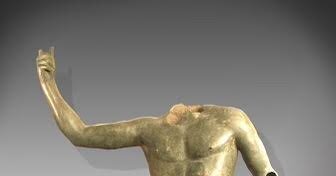A California collector has gone to court to block efforts by New York investigators to seize an ancient Roman bronze statue that they assert was looted from Turkey in the 1960s.
In a federal court filing last week in California, lawyers for the collector, Aaron Mendelsohn, 74, disputed the evidence they said investigators had presented indicating that the ancient statue of a man was stolen from an archaeological site in Turkey. The lawyers said that investigators had no jurisdiction to seize items in California and so were overstepping their authority.
It was the latest in a series of recent challenges to efforts by the Manhattan district attorney’s office to seize artifacts believed to have been looted. The Cleveland Museum of Art and the Art Institute of Chicago are also engaged in legal challenges with the investigators over items with disputed histories.
In Mr. Mendelsohn’s case, his lawyers have accused the investigators of using the threat of prosecution to pressure their client into giving up the statue. In addition, they have argued that by pursuing the statue in a potential criminal proceeding, the investigators can avoid the fuller disclosure and access to evidence that would have been required in civil court.
The district attorney’s office “has invoked New York criminal process in an effort to intimidate Mr. Mendelsohn into relinquishing the Bronze Male, without affording Mr. Mendelsohn a legitimate opportunity to fully explore the evidence that DANY claims casts doubt on Mr. Mendelsohn’s ownership or to litigate its true ownership,” Marcus A. Asner, a lawyer for Mr. Mendelsohn, wrote in court papers filed in U.S. District Court for the Central District of California, Western Division.
Manhattan district attorney’s office responded with a statement that said: “Our Antiquities Trafficking Unit has successfully recovered thousands of stolen antiquities that came through Manhattan from galleries, homes, and museums around the country. We will respond to this filing in court.”
The statue is thought by investigators in New York and Turkey to be part of a grouping once created at a shrine that was built during Roman rule, around A.D. 50 to A.D. 250, in what is today southwestern Turkey, to honor a succession of Roman emperors. Investigators say that many of the statues were stolen in the 1960s during a looting spree by villagers at the archaeological site, called Bubon.
In the past few years, as part of its investigation into Turkey’s claims that artifacts were looted, the district attorney’s Antiquities Trafficking Unit has returned several other statues thought to have been from the same location, including pieces seized from the Metropolitan Museum of Art and the Museum of Greek, Etruscan, and Roman Art at Fordham University, among others.
But last year the Cleveland Museum of Art went to federal court in Ohio to block the seizure of one of its premier statues, a headless bronze. Investigators believe the bronze, valued at $20 million, also came from Bubon and depicts the great Roman statesman Marcus Aurelius.
The Cleveland case is the focus of attention among lawyers waiting to see whether the outcome will limit the authority of the Manhattan prosecutors.
According to the court papers, Mr. Mendelsohn bought the statue in 2007 from a New York art dealer, Royal-Athena Galleries, for about $1.33 million.
The bronze was described by the dealer in its invoice as “ROMAN BRONZE MONUMENTAL MALE MEMBER OF THE IMPERIAL FAMILY IN HEROIC POSE.” The provenance was “Said to be from Bubon, Turkey. Late 2nd — early 3rd Century AD”; it had previously been in a Boston private collection, which had acquired it in Switzerland.
Elizabeth Marlowe, a professor at Colgate University in New York, who has advised the district attorney’s office on the Bubon investigation, said the statue was one of two sold by the gallery. It was accompanied at the time, she said, by a letter from Cornelius Vermeule, then curator of classical antiquities at the Museum of Fine Arts in Boston, that endorsed it as having come from Bubon.
“That’s significant because Vermeule was the first American scholar to start tracking the Bubon case and was the undisputed authority,” she said.
Mr. Mendelsohn’s lawyers said he would return the statue to Turkey if the evidence showed it had been looted.
But they wrote: “The evidence presented by DANY does not provide a sufficient basis to conclude that the Bronze Male was looted and illegally exported from Bubon in the 1960s, let alone that it originated from Bubon in the first place.”
“DANY’s claim of origin rests on inconsistent and incomplete historical records, unreliable testimony from a single witness about an event that happened over fifty years ago, and highly suggestive photo arrays and sequences of various bronze statues shown to that single witness,” the filing said.
According to the court papers, in January, New York investigators sent Mr. Mendelsohn a request for documents and correspondence relating to the statue and summoned him by subpoena to appear before a grand jury in New York. He did not accept the subpoena and instead had his lawyers contact investigators.
In moving to seize items held by institutions or collections outside of New York, the Manhattan district attorney’s office has argued that it has jurisdiction because the items had passed through, or been sold in, New York.
Out-of-state museums like the J. Paul Getty in Los Angeles and the Carnegie Museums in Pittsburgh have given up items voluntarily after the investigators presented evidence that they were stolen property that had passed through New York.
Mr. Mendelsohn’s lawyers noted that the bronze statue had been in their client’s possession in California for 17 years, but “the statute of limitations for criminal possession of stolen property under New York penal law is five years,” meaning the opportunity for prosecution has expired. They asked the court to declare Mr. Mendelsohn the rightful owner of the statue.
Read More: Collector Sues to Block Investigators From Seizing Roman Bronze


